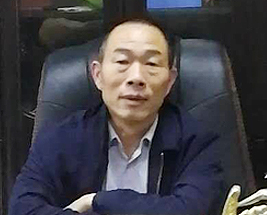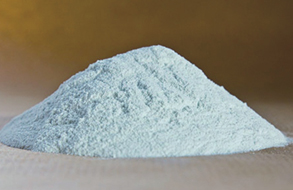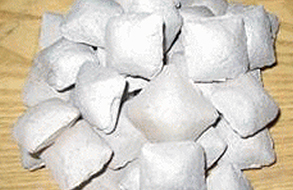- Set up in 2011, our company is located in Luoyang city, Henan province, and covers an area of 30 Mu (about 20,000 square meters). We have a designed annual production capacity of 1,000t of ammonium metavanadate 98%min, 99%min and 99.5%min. As a well-known Chinese vanadium company, we always maintain uninterrupted operation no matter in the ups or in the downs of the vanadium industry.
- Asian Metal: Hello, Mr. Lv. Thanks for taking our interview. Would you please first give a brief introduction on your company?
- Mr. Lv: Set up in 2011, our company is located in Luoyang city, Henan province, and covers an area of 30 Mu (about 20,000 square meters). We have a designed annual production capacity of 1,000t of ammonium metavanadate 98%min, 99%min and 99.5%min. As a well-known Chinese vanadium company, we always maintain uninterrupted operation no matter in the ups or in the downs of the vanadium industry.
Ammonium metavanadate (NH4VO3≥98%, 99% and 99.5% on dry basis, white or yellowish crystal, production standard GB-7315-87)
- Asian Metal: Thanks. Does the vanadium market is experiencing an exorbitant-profit period? How long will this period last?
- Mr. Lv: Indeed, now it's an exorbitant-profit period for the vanadium market where the most profiting companies are the upstream vanadium pentoxide producers. With relatively fixed production costs, they can directly benefit from increases in vanadium prices. Generally speaking, production costs are commercial secrets for a company; but if we consider the publically available information, we estimate that there is a profit margin of at least 200% for vanadium pentoxide companies. But for downstream ferrovanadium and vanadium nitride producers, things are different. Though prices for downstream vanadium products move up, their costs on purchasing raw materials also rise, and so their profit margins are fixed. But anyway, the overall situation for them is much better than in the previous years. I think that no great changes will happen to supply shortage of raw materials in the near future; and maybe one or two years later when China's vanadium extraction capacity from stone coal increase, the upward trend in vanadium prices may be contained to some extent.
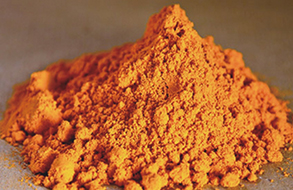
Vanadium pentoxide (V205 98%min, 99%min and 99.5%min, saffron powder, production standard GB/T3283-87)
- Asian Metal: Which factor, changes in industrial policies or increasing downstream demand, can the current dramatic increases in vanadium companies' profits be attributed to? How do you think of the current Chinese vanadium market?
- MR. Lv: The current vanadium market is at a very flourishing stage within the recent three or four years as vanadium prices keep moving up dramatically. This can be attributed on one hand to recovering downstream demand, and in a larger part to changes in industrial policies which result in tightening supply of vanadium raw material. Those policies include banning on importing vanadium slag, environmental inspections and overcapacity reduction in the steel industry. In addition, when vanadium prices go up dramatically, stocks of low-grade vanadium pentoxide available in the market have run out. Affected by the overcapacity cut, Chinese steel mills reported decreases in their iron outputs and so supply of vanadium slag reduces dramatically; as a result, raw material supply for producing vanadium pentoxide becomes severely scarce in major production regions such as Panzhihua city, and accordingly supply of vanadium pentoxide is monopolized by just a few major producers.
- I think this is a quite dangerous situation. With downstream demand increasing, especially with the new industrial standards on rebar to go into effect, the Chinese market will see a serious gap in supply of vanadium products, which is why vanadium prices soar. While when we look at the international market, advanced countries have enough vanadium-contained catalysts and slag; but owing to the pollution during the production process, plants are not allowed to use those raw materials to produce vanadium products within advanced countries; in comparison, developing countries such as Vietnam have more lenient environment for production. So quite a few companies tend to move their plants to developing countries. We are also considering whether it's feasible for us to build our plants in such countries to produce vanadium pentoxide. If vanadium prices keep going up, vanadium products provided by overseas suppliers are set to flow into the Chinese market to meet the domestic need, and this will surely impose threats upon Chinese vanadium companies.
Issues we face can be summarized into two categories:
1. The overseas market has sufficient supply of raw material but is unable to maintain large-scale production;
2. The Chinese market has a great amount of idle production capacity as we suffer from deficient supply of raw material.
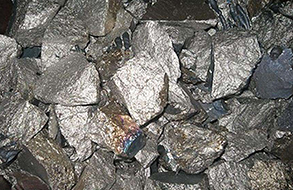
Ferrovanadium (FeV50%min, FeV80%min, grain size <100mm, production standard GB/T4139-2004)
- Asian Metal: The new national standard on rebar will go into effect on November 1. What effects do you think the new standard will impose upon the supply-demand status in the Chinese vanadium market?
- MR. Lv: The new rebar standard will surely spur downstream demand for vanadium products to pick up quickly. But considering the current status of raw material supply, we can say that it's far from being enough, and so vanadium prices are expected to keep going up for a long time. But if vanadium prices go up too dramatically within a short period, niobium products will surely be adopted as substitutes. According to Karl Marx, a certain 10 percent will ensure its employment anywhere; 20 percent will produce eagerness, 50 percent positive audacity; 100 percent will make it ready to trample on all human laws; 300 percent, and there is not a crime which it will not scruple, nor a risk it will not run, even to the chance of its owner being hanged. So if supply shortage in the vanadium market intensifies continuously, the market environment will finally loosen up.
vanadium nitride (V77%-81%, N14%-18%, grain size 10-40mm, production standard GB GB/T20567-2006)
- Asian Metal: Prices for vanadium pentoxide flake keep going up, and what do you think is the price ceiling for them?
- MR. Lv: The continuous upward movement in vanadium pentoxide flake prices is totally decided by the supply-demand status. Affected by new industrial policies, vanadium slag is banned from being imported, and environmental protection policies prevent small-sized vanadium plants and plants extracting vanadium from stone coal from increasing their outputs. As a result, the vanadium pentoxide flake market falls into severe supply shortage, and therefore it becomes inevitable for prices to soar. But in my opinion, vanadium prices can't keep going up all the way ahead. When they reach a certain point, many small-sized producers will be goaded to resume production while trying to dodge government inspections, and accordingly supply will increase and prices will surely fall back. In addition, though Chinese government bans importing vanadium slag, there are no restrictions on importing ferrovanadium and vanadium nitride. So if vanadium prices in the Chinese market keep rising, overseas suppliers are surely encouraged to expand their businesses into the Chinese market. At present, Chinese vanadium output accounts for about 30% of the global total, and if we talk only from the supply-demand perspective, abundant resource in the overseas market will be able to meet demand from the Chinese market. Once conditions on importing from abroad mature, the upward trend in the Chinese vanadium market can be restrained by importing from overseas markets. The market price is relative. As long as there is demand in the downstream, the price rise is reasonable. There is no concept of top.I estimate that the price of V2O5 98%min will remain above 400,000 yuan/ton for a long time.
- Asian Metal: What are the main factors restraining increases in raw material supply in the Chinese vanadium market?
- MR. Lv: Except plants which extract vanadium from stone coal, Chinese suppliers of vanadium raw material have basically reached their full-scale operation, and if they want to increase outputs, they can only build more production lines. There are quite a few factors stemming vanadium raw material supply from increasing, but the most core factor is China's environmental policies. Banning on importing vanadium slag, small-sized producers shutting down, no plans on building new vanadium-extracted-from stone-coal plants to be approved, and existing such plants slow in increasing their outputs, all these reasons contribute to the hardness in increasing vanadium raw material supply in China. And in the light of the current situation, I believe that supply shortage is unlikely to be abated in the short term.
- Asian Metal: Does your company have any output increase plans since demand for vanadium products is good?
- MR. Lv: We have no plans for increasing outputs, but we indeed very hope to reach full-capacity production as our operating rate for ammonium metavanadate is only 50%. The main reasons for our low operating rate are environmental policies and unavailability of vanadium slag. In particular, prices for vanadium slag directly link up with vanadium prices, and we never feel buying enough high-quality vanadium slag.
- Asian Metal: How do you think of future development trend on the vanadium extraction industry from stone coal?
- MR. Lv: Smooth development of this industry is the most effective way to increase raw material supply for the vanadium market. At present traditional extraction companies keep normal production and their vanadium pentoxide outputs are also on the rise in a planned way. But for small-sized extraction plants or for companies planning to build new extraction plants, it will be difficult for them to do this. For the former, it will cost them huge amounts of money to carry out equipment upgrading and to maintain normal operation later. Take waste water treatment as an example. It costs as high as RMB2,000-3,000 (USD292-439/t) to crystallize one ton of waste water by evaporation process. So high production costs make it difficult for such extraction plants to continue with their operation and so many of them shut down. While for companies which plan to build new extraction plants, they can't have their plans to be approved at all by environmental authorities. So if pressure from environmental authorities does not abate, I have no confidence that the overall extraction industry would be able to increase its output.
- Asian Metal: Do you have any suggestions to Asian Metal on our role as an industrial information website in the development of vanadium industry?
- MR. Lv: In an era of information today, upstream, midstream and downstream companies in the vanadium chain are all sensitive to information. A piece of news can spread to every corner of the market when it just comes out, and anyone who has direct and convenient access to information can gain a better position in negotiations. Industrial information websites are effective intermediary agents on information, but they also can do harm to the industry if they fail to maintain their neutrality. Only websites which are always neutral, timely in collecting accurate information, and provide only unbiased points of views can lead the market into healthy development. Asian Metal has been long devoted into doing this and this is quite praiseworthy. We hope that Asian Metal will continue to take the lead in the metal information industry and make your share of contribution to a better vanadium market.
- Asian Metal: Thanks very much for sharing your views with us!
